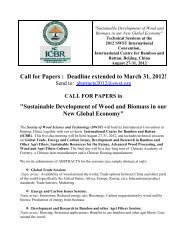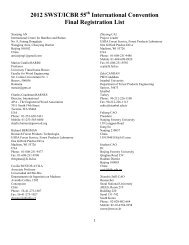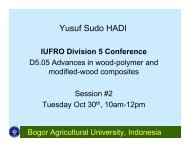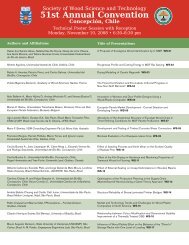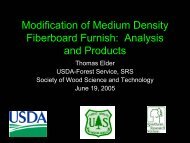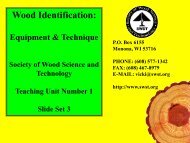Weihong WANG, N - Society of Wood Science and Technology
Weihong WANG, N - Society of Wood Science and Technology
Weihong WANG, N - Society of Wood Science and Technology
Create successful ePaper yourself
Turn your PDF publications into a flip-book with our unique Google optimized e-Paper software.
Northeast Forestry University<br />
(NEFU)
Material <strong>Science</strong> & Engineering<br />
College<br />
2000 students (500 graduate students)<br />
115 staffers<br />
One first-degree national subject:<br />
Forestry engineering<br />
One key lab <strong>of</strong> Education Ministry :<br />
Bio-based material science & technology
Speciality:<br />
<strong>Wood</strong> science <strong>and</strong> engineering,<br />
Forest products chemical process ,<br />
Material chemical, Paper manufacturing<br />
Furniture design <strong>and</strong> interior decoration<br />
Vision expression
Agricultural Straw Reinforcing<br />
Polypropylene by Hot Pressing<br />
Dr. <strong>Weihong</strong> Wang<br />
Kay lab <strong>of</strong> Bio-based material <strong>Science</strong> <strong>and</strong> technology<br />
<strong>of</strong> Education Ministry (Northeast Forestry University)<br />
August 27-31, 2012 - Beijing, CHINA
Content<br />
• Back ground<br />
• Prepare straw/HDPE composite by<br />
hot pressing<br />
• Property test <strong>and</strong> results<br />
• Conclusion
• Straw resource<br />
700 M ton annually<br />
• <strong>Wood</strong> plastic composite (WPC)
Why do we use hot pressing method ?<br />
• Agriculture straw is an abundant resource<br />
• Thermo-degradation occurs during<br />
extrusion<br />
• Present research :<br />
Use straw in WPC industry by hot<br />
pressing
• Advantages <strong>of</strong> hot pressing process<br />
Large size celllulosic raw materials<br />
Large size board<br />
Less thermo-degradation
Problem in hot pressing method<br />
1)Not completely melt<br />
2)Not uniformly mixing<br />
Key means<br />
1)Ensure effective hot pressing time<br />
2)get similar bulk density
1 prepare straw/HDPE<br />
composite by hot pressing<br />
Straw particle<br />
Cold press<br />
Mix<br />
Spread<br />
Mat<br />
Hot press<br />
Plastic pellet<br />
Mat<br />
Preheat<br />
Plastic fiber
Advantages<br />
• Uniformly mixing<br />
• Elevate the temperature <strong>of</strong> mixture mat<br />
<strong>and</strong> shorten hot pressing time<br />
• Evaporate moisture in straw
1.1 Prepare straw/HDPE powder composite
• Property test<br />
Bending strength (BS)<br />
Modulus <strong>of</strong> elasticity (MOE).<br />
Thickness swelling (TS).<br />
Internal bonding strength (IB).
Table 1 Effects <strong>of</strong> straw particle size <strong>and</strong> preheating<br />
treatment on the properties <strong>of</strong> straw/HDPE powder<br />
composite (16cm×16cm×0.9cm)<br />
Treatment Straw size<br />
(mesh)<br />
Density<br />
(g/cm 3 )<br />
BS<br />
(MPa)<br />
MOE<br />
(GPa)<br />
2 h TS<br />
(%)<br />
24 h TS<br />
(%)<br />
Without<br />
preheating<br />
16 – 8 0.68<br />
(0.021)<br />
5.66<br />
(0.411)<br />
0.82<br />
(0.069)<br />
30<br />
(2.471)<br />
35<br />
(3.999)<br />
Preheating 16 – 8 0.69<br />
(0.022)<br />
7.44<br />
(0.569)<br />
1.11<br />
(0.073)<br />
20<br />
(1.756)<br />
22<br />
(3.008)<br />
40–16 0.62<br />
(0.025)<br />
9.05<br />
(0.845)<br />
1.26<br />
(0.096)<br />
14<br />
(1.850)<br />
19.05<br />
(0.845)
Straw fiber/HDPE powder composite by hot pressing<br />
(16 ×16 ×0.9 cm)
1.2 Prepare straw/HDPE fiber composite
Spread, preheat, hot press, <strong>and</strong> cold press
2 Properties <strong>of</strong> straw/HDPE<br />
composite<br />
2.1 Comparing straw /HDPE powder <strong>and</strong><br />
straw/HPDE fiber composite<br />
2.1 Properties <strong>of</strong> straw/HDPE fiber <strong>and</strong><br />
straw/PP fiber composites
2.1 Comparing straw /HDPE powder <strong>and</strong><br />
straw/HPDE fiber composite<br />
Table2 Effect <strong>of</strong> HDPE shape on the properties<br />
<strong>of</strong> straw/HDPE composite<br />
HDPE<br />
shape<br />
Density<br />
(g/cm 3 )<br />
BS<br />
(MPa)<br />
MOE<br />
(GPa)<br />
2 h TS<br />
(%)<br />
24 h TS<br />
(%)<br />
Powder 0.62<br />
(0.025)<br />
9.05<br />
(0.845)<br />
1.26<br />
(0.096)<br />
14<br />
(1.850)<br />
19.05<br />
(0.845)<br />
Fiber 0.55<br />
(0.029)<br />
11.36<br />
(1.058)<br />
1.12<br />
(0.097)<br />
10<br />
0.102)<br />
15<br />
1.397)
2.2 Properties<br />
<strong>of</strong> straw/HDPE fiber composites<br />
Table 3 Properties <strong>of</strong> wheat straw/HDPE fiber composite<br />
with <strong>and</strong> without coupling agent (16cm×16cm×0.9cm)<br />
Density<br />
(g/cm 3 )<br />
BS<br />
(MPa)<br />
MOE<br />
(GPa)<br />
2 h TS<br />
(%)<br />
24 h TS<br />
(%)<br />
IB<br />
(MPa)<br />
Without<br />
coupling<br />
agent<br />
0.55<br />
(0.029)<br />
11.36<br />
(1.058)<br />
1.12<br />
(0.097)<br />
10<br />
0.102)<br />
15<br />
1.397)<br />
0.24<br />
(0.020)<br />
Containing<br />
MAPE<br />
0.59<br />
(0.022)<br />
17.61<br />
(1.627)<br />
1.23<br />
(0.198)<br />
9<br />
(0.906)<br />
10<br />
(1.000)<br />
0.32<br />
(0.017)
Table 4 Properties <strong>of</strong> wheat straw/HDPE fiber <strong>and</strong><br />
straw/PP fiber composites (35 cm×35 cm×1 cm)<br />
Straw:<br />
HDPE<br />
60:40<br />
MAPE<br />
(%)<br />
Density<br />
(g/cm 3 )<br />
4 0.70<br />
(0.017)<br />
BS<br />
(MPa)<br />
17.00<br />
(1.197)<br />
MOE<br />
(GPa)<br />
1.57<br />
(0.152)<br />
IB<br />
(MPa)<br />
0.55<br />
(0.028)<br />
2 h<br />
TS<br />
(%)<br />
24 h<br />
TS (%)<br />
9.00<br />
(0.899)<br />
Straw:PP<br />
60:40<br />
4 0.73 36.76 2.92 0.77 1.77
Table 5 Ratio <strong>of</strong> PP to straw<br />
No. Length <strong>of</strong> PP<br />
fiber (cm)<br />
PP: straw<br />
1<br />
30:70<br />
2 35:65<br />
3 40:60<br />
4 3-5 45:55<br />
5 50:50<br />
Mesh <strong>of</strong><br />
straw particle<br />
20-40
TS/%<br />
2h<br />
40<br />
35<br />
30<br />
25<br />
20<br />
15<br />
10<br />
5<br />
0<br />
30:70 35:65 40:60 45:55 50:50<br />
Mass ratio <strong>of</strong> PP to straw<br />
PP 与 稻 草 质 量 比<br />
IB/MPa<br />
0.45<br />
0.4<br />
0.35<br />
0.3<br />
0.25<br />
0.2<br />
0.15<br />
0.1<br />
0.05<br />
0<br />
30:70 35:65 40:60 45:55 50:50<br />
Mass ratio PP <strong>of</strong> 与 PP 稻 草 to 质 量 straw 比<br />
35<br />
3.5<br />
30<br />
3<br />
MOR/MPa<br />
25<br />
20<br />
15<br />
10<br />
5<br />
0<br />
30:70 35:65 40:60 45:55 50:50<br />
Mass ratio <strong>of</strong> PP to straw<br />
PP 与 稻 草 质 量 比<br />
MOE/GPa<br />
2.5<br />
2<br />
1.5<br />
1<br />
0.5<br />
0<br />
30:70 35:65 40:60 45:55 50:50<br />
Mass ratio <strong>of</strong> PP to straw<br />
PP 与 稻 草 质 量 比<br />
Effects <strong>of</strong> the ratio <strong>of</strong> PP to straw on the properties <strong>of</strong><br />
straw/PP fiber composite
1 Without MAPP <strong>and</strong> preheating<br />
2 With MAPP <strong>and</strong> preheating<br />
without pressure<br />
3 With MAPP<br />
4 With MAPP <strong>and</strong> preheating<br />
under pressure
1 Without MAPP <strong>and</strong> preheating<br />
2 With MAPP <strong>and</strong> preheating<br />
without pressure<br />
3 With MAPP<br />
4 With MAPP <strong>and</strong> preheating<br />
under pressure
Preheat without pressure<br />
preheat under pressure
3 Veneer covered<br />
straw/PP fiber composite<br />
Veneer<br />
PP fiber <strong>and</strong> straw mixture<br />
Veneer<br />
Preheat<br />
Method A<br />
Hot press<br />
Cold press
PP fiber <strong>and</strong> straw mixture<br />
Preheat<br />
Cold press<br />
Method B<br />
Hot press<br />
Hot press<br />
Veneer<br />
Cold press<br />
Veneer<br />
Straw/PP composite panel
• Property test<br />
Surface bonding strength<br />
surface wettabilty
Sample treatment :<br />
Boiling/4h,<br />
Drying at 63±3℃/20h,<br />
Boiling/4h,<br />
Drying at 63±3℃/3h<br />
Sample size: 75mm×75mm
Method B<br />
Method A<br />
Table Separation between surface veneer <strong>and</strong> composite panel<br />
Separation after boiling (mm)<br />
Overlaying Method a b c d e f Total<br />
Method A-- Preheating<br />
<strong>and</strong> hot pressing together<br />
Method B -- Overlaid on<br />
straw/PP composite panel<br />
0 0 0 0 0 0 0<br />
1 2 1 1 2 2 9
Conclusion<br />
• Preheating the mat before hot pressing can<br />
provide better properties <strong>of</strong> straw reinforcing<br />
thermoplasitc composite.<br />
• Thermoplastic in fiber shape mixes more<br />
uniformly with straw particles than in powder<br />
shape <strong>and</strong> improves the properties <strong>of</strong> the.<br />
• Veneer could be overlaid directly on the surface<br />
<strong>of</strong> straw/PP fiber composite by the aid <strong>of</strong> PP<br />
accumulated on the surface. No other adhesive<br />
was used. And the etability <strong>of</strong> surface veneer<br />
almost was not effected.
Acknowledge :<br />
gang Li, Chenxi zhang, Senlin Yuan, Fanhua<br />
Pu, Haigang Wang, Qingwen Wang<br />
weihongwang2001@yahoo.com.cn
Thank you





